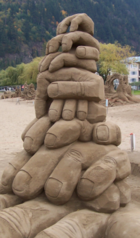Podcasting 101
Introduction
In this lesson, the uses and benefits of educational podcasting will be explored. As well, learners will experiment with creating their own basic podcast.
Intended Audience
This educational resource is designed for educators at all levels.
|
After completing this lesson, you will be able to:
|
Podcast
Click on the audio link below to start the download of the podcast. Not recommended for dialup connections!
|
| Introduction to podcasting
Common Craft is company that produces exceptional educational videos on a variety of topics.
|
Discussion
Podcasting is a popular and broad-sweeping phenomenon. As such, podcasting provides an invaluable source of authentic and communicative language in use (Brown, 2001). Further, auditory and verbal learners will benefit with the availability of recordings, narrations, and sound effects. With the rising use of digital audio players (with Apple iPods leading the way), podcasting is poised to become an instrumental educational tool.
|
Learning in Hand is an excellent web resource on podcasting. Focus for reading
|
Discussion
Podcasts can be listened to practically anywhere and anytime. This time-shifting characteristic is just one of the benefits of podcasting. In essence, this technology allows individuals to become their own 'radio hosts' opening many educational applications such as:
- recording personal introductions/greetings to new students
- recording lectures (in fact, in a recent study listeners of podcasted lectures outscored live lecture listeners)
- providing tutorials
- telling stories
- recording class discussions
- conducting interviews
With minimal investment and scaffolding, students can easily produce their own podcasts to fulfill school assignments. Possible applications include:
- musical recitals
- language learning practice
- reenactments
- oral reports
In addition, 'ready-made' podcasts are available online. One source for free podcasts is iTunes UTM which offers over 100,000 educational audio and video media files.
| Reflection
A podcast is a cost-effective means to enhance learning. As podcasting technology grows in popularity, so does the opportunity to leverage its use in educational situations. Application
Optional activity
|
How to Start Podcasting
Equipment needed
Podcasting is quite an easy and economical educational technology to explore. Equipment required is readily accessible, and if you already have access to a computer (assuming your computer doesn't not come equipped with a built-in microphone), all you really need is a microphone.
Microphones
There are a variety of choices here. One option is a stand alone microphone, another option is a microphone/headset combination.
Field Recorders
Another option for capturing a podcast is a handheld field recorder. These recorders allow the user to create digital sound files onto media storage such as a secure digital (SD) card.
- Images by LStollings
Software Options
AudacityTM
- AudacityTM is free, open-source software program which allows the user to create, edit and mix .wav and .mp3 audio files.
- To view the short Introductory to AudacityTM video below, click the arrow button at bottom left-hand corner of the screen. (If you have a low bandwidth connection, you may want to skip this)
<flash>file=Audanine.swf|width=400|height=380|quality=best</flash>
For more information on using Audacity
- review the excellent WikiEducator page on Using AudacityTM
- download a brief guide to using AudacityTM Quick Guide to Audacity 2008
- consult the AudacityTM Wiki Page
SkypeTM
- Another option for capturing audio is through the use of SkypeTM (a free Internet telephone service). You can record interviews and discussions (with up to five people) using this software plus the SkypeTM recording add-on by PowerGramo (which starts at about $24 to download)
GarageBandTM
- For Mac users, GarageBandTM is a premiere sound recording and editing software feature. As well, users can arrange and compose original music with GarageBand and add a variety of special sound effects.
Other Options
- There are a number of other options for podcasting software which can be downloaded for a fee. Some examples can be found on the Podcasting Tools site.
Hands On
| Create your own podcast
In this activity you will create your own podcast.
|
Copyright considerations
Creative Commons offers a comprehensive guide titled Podcasting Legal Guide for Canada which outlines important information with regard to Canadian copyright and podcasting. As well, Creative Commons provides a guide which outlines Legal Guidelines for Podcasting in the US.
Where to publish your podcasts
You can upload your podcasts to a website or a blog, or email to individuals, but many podcasters publish their work to the internet. The following are some suggestions as to where you can publish your podcasts for free.
There are also many options as to where you can publish your podcasts for a minimal fee.
Once your podcasts are shared or published, they can be uploaded to an MP3 player allowing users to take these files 'on the road.' This portability is a true benefit in our mobile world.
A primer on RSS feeds
As you begin to publish your work, you will begin to discover the power of RSS feeds. RSS stands for Real Simple Syndication. This technology allows individuals publishing blogs, podcasts, news stories etc., to 'push' their most current content to their 'subscribers.' For an introduction to this technology, view Commoncraft's brief video RSS in Plain English.
Web resources
For more information on podcasting, refer to the following resources:
- Podcasting Tools (extensive website with a variety of resources)
- How Stuff Works: Podcasting
- O'Reilly's Digital Media: What is Podcasting
- How to Podcast (Basic tutorial and links to software sources)
- Podcasting: Co-opting MP3 Players for Education and Training Purposes (Academic paper)
- Educational Podcasting: Fad or Future (Academic paper)
There is a wealth of material on podcasting on the web. The above is just a small sample of available resources.
The beginning
Now that you have begun to explore the world of podcasting, you will soon discover that there is a wealth of online podcasts available for educational use. As observed by Richardson (2006), podcasting gives individuals the chance to create and contribute ideas to "the larger conversation, and it's a way of archiving that contribution for future audiences to use" (p. 116). Have fun, enjoy the creativity of others, and don't be afraid to bring your own imagination to the mike.
References
Brown, H. D. (2001). Teaching by principles: An interactive approach to language pedagogy. New York: Longman Inc.
Richardson, W. (2006). Blogs, wikis, podcasts, and other powerful web tools for classrooms. Thousand Oaks, CA: Corwin Press.





